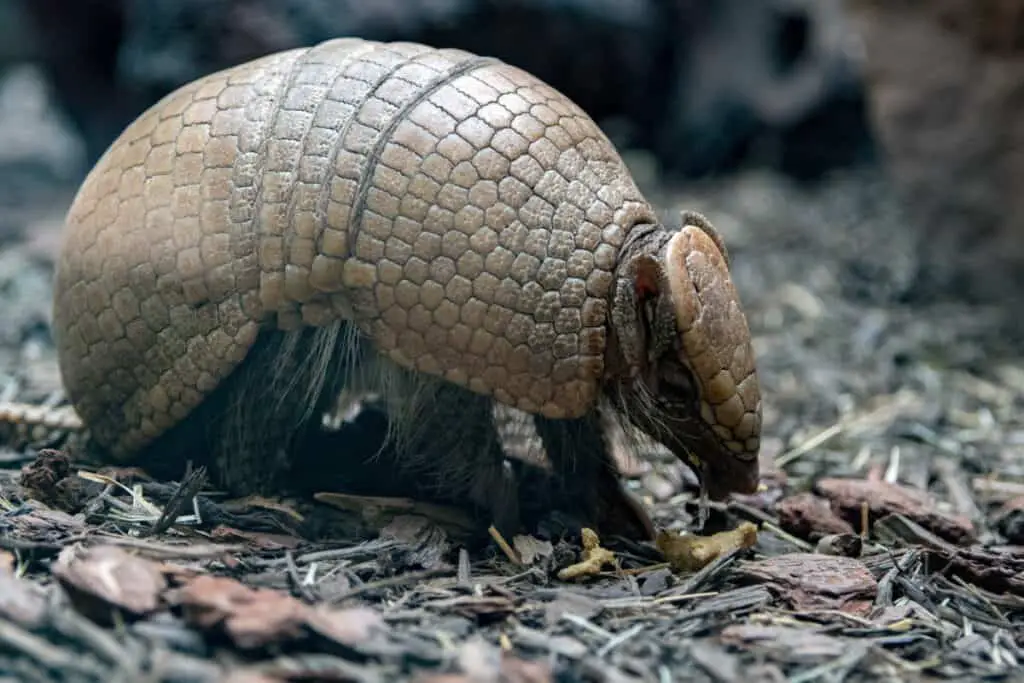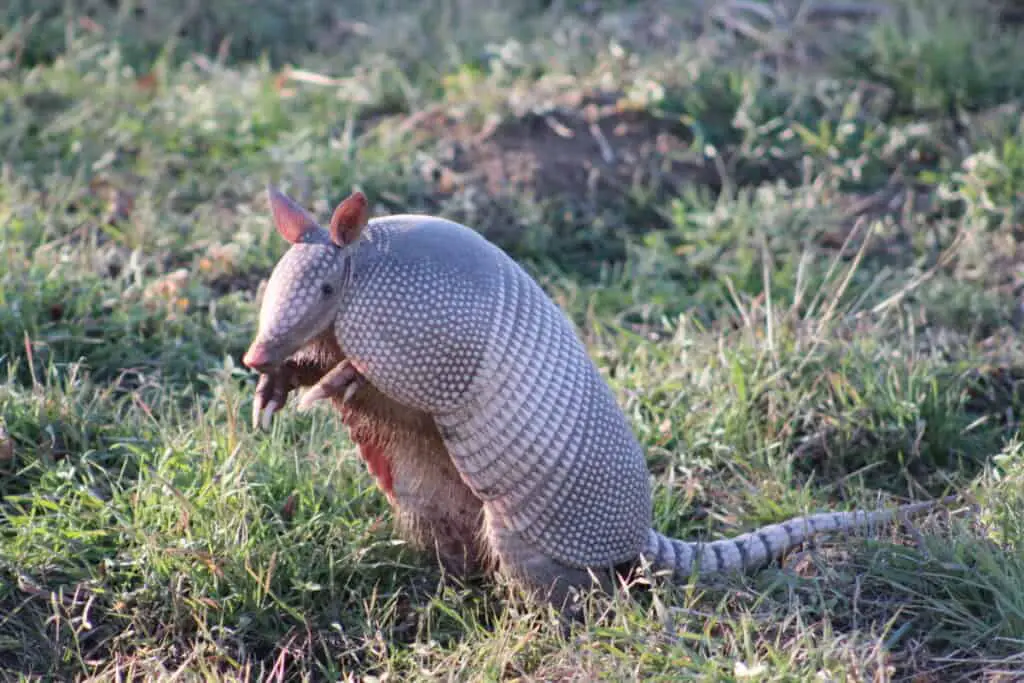Armadillos are one of the most recognizable animals in North and South America due to their distinctive armor-like shell.
Despite this, relatively little is known about what armadillos eat. A study conducted on a group of nine Nine Banded Armadillos (Dasypus novemcinctus) living in Central Texas provides insight into the diet of these creatures.
The armadillos were observed for three months during which time researchers documented what they ate and how much energy they expended while doing so.
The results showed that the armadillos primarily fed on insects such as ants and beetles, with some additional vegetation such as fruits and flowers also making up part of their diet.
Additionally, it was seen that the amount of energy used by each animal varied depending on its size and activity level, suggesting that different individuals may have slightly different diets.

Overview Of Armadillo Diet
Armadillos, members of the Xenarthra order, are small to medium-sized mammals natively found in Central and South America. Their diet varies depending on species, with their foraging behavior impacting what they consume as well as when and where they obtain it.
Armadillo habitat selection depends largely on the availability of food sources such as fruits, seeds and nuts, invertebrates, amphibians, reptiles and carrion. Digging is an important form of foraging behavior among armadillos; this enables them to feed on burrowing insects like ants and grubs which inhabit the soil.
They can also use their sharp claws to dig up tubers and roots from underground vegetation. Additionally, some species have been observed feeding on fallen fruit or scavenging carcasses from other animals. The majority of their diet consists of insects however; beetles forming a large part of this insectivore’s sustenance.
Types Of Insects
Armadillos are opportunistic omnivores, and their foraging methods typically involve searching for food on the ground. They consume a variety of insects such as spiders, earthworms, snails, centipedes and beetles – to name just a few. Insects make up the majority of an armadillo’s diet; they also feed on fruits, small vertebrates like lizards or frogs, eggs, carrion and even plants.
The role of insect-eating armadillos in pest control is significant due to their efficient search patterns that cover large areas. Armadillos can be beneficial when it comes to controlling populations of certain agricultural pests by preying upon them and disrupting their life cycle. Furthermore, larger armadillo species often eat rodents which pose a greater threat to crops than other insects do.
In this way, armadillos provide an additional layer of protection against crop damage from those types of rodents. As such, understanding the ecology and behavior of these animals could lead to effective management strategies for farmers seeking ways to reduce losses from pests without using chemical pesticides.
Unveiling the Sensory Abilities of Armadillos: How Good Are Their Senses?
Types Of Vegetation
Staggering through the soil, armadillos have an appetite for a variety of insects and vegetation. While they are known to be voracious insectivores, they also rely on plants to fulfill their dietary needs. Foraging habits and habitat selection play a crucial role in determining which food sources armadillos consume.
Armadillos scour diverse environments for sustenance including grasslands, forests, deserts, and wetlands. They use their sharp claws to dig up beetles from beneath the earth’s surface or feed upon rotting logs that house termites and ants. Armadillos will also eat fruits such as apples and berries, frogs, bird eggs, lizards, snakes, small mammals like mice, and carrion when available.
In addition to these items found in nature, some species of armadillo may seek out human-made food like corn or other grains left unprotected by farmers. With this wide range of options at hand, it is no surprise that armadillos have become so successful worldwide while adapting to different climates.
Armadillos’ Dietary Secrets Unveiled
Variation In Diet
Armadillos have a wide variety of foraging habits, depending on the species and their environment. Generally speaking, armadillos are omnivorous, meaning they consume both animal matter (e.g., insects, larvae) and plant material (e.g., fruits or roots). They can also hunt small vertebrates such as lizards, snakes or amphibians in some cases.
The type of food an armadillo consumes depends heavily on its burrowing behavior; those that dig deeper holes to sleep in tend to focus more on grubs and worms while armadillos with shallower dens will feed mostly on plants, fruits, and nuts.
Additionally, many species vary their diet seasonally based off availability of resources in order to meet nutritional needs:
- In spring and summer months when protein sources are plentiful, adult armadillos eat more invertebrates than at any other time of year
- During autumn and winter months when prey is scarce, these animals rely mainly on foliage
- Some species even switch between insectivory and herbivory throughout the day
Given their adaptability and versatility in finding nutrition sources, it’s not surprising that armadillos occupy diverse habitats across multiple continents. Different climates support different types of vegetation which allows them to survive by selectively eating what will benefit them most nutritionally.
Despite this flexibility however, overhunting continues to threaten several species worldwide due to humans seeking out their meat as a source of sustenance or profit.
Armadillo’s Sensory World: Exploring Their Senses
Energy Expenditure
Armadillos are primarily insectivorous, with a diet consisting mostly of ants and termites. They also feed on other arthropods such as beetles, crickets and grasshoppers. Their foraging behavior is largely nocturnal and they spend most of their time searching for food in the ground or under logs.
The metabolic rate of armadillos is relatively low compared to other mammals because their bodies are adapted for living in warm climates. As ectotherms, they depend more heavily on external sources of heat than endothermic animals which regulate body temperature internally. This makes them less active during cold weather since they need to remain inactive in order to conserve energy.
Additionally, this adaptation allows armadillos to have longer periods between meals due to their reduced metabolism so that they can afford extended bouts of sleep without needing frequent feeding sessions.
Unveiling the Armadillo’s Predators

Implications For Conservation
The diet of armadillos is varied, but mostly consists of insects, grubs, fruit and other small animals. This dietary variety reflects the fact that most species are opportunistic feeders, consuming whatever food sources happen to be available at any given time.
As such, they can survive in a number of different habitats provided there is adequate food supply. However, climate change and habitat destruction has drastically reduced the population numbers of many species of armadillo over recent years.
Given their dietary versatility and adaptability to various conditions, conservation efforts should focus on protecting the habitats where these creatures live as well as identifying potential artificial feeding sites which could supplement dwindling natural resources due to human activities.
Furthermore, research into new methods for educating people about the importance of preserving biodiversity will also play an important role in helping protect populations of armadillos from extinction. Restricting hunting practices and increasing awareness among local communities would also help ensure that future generations are able to enjoy seeing wild armadillos living in their natural habitats.
Conclusion
The diet of armadillos is varied, but mainly consists of insects and small invertebrates.
Vegetation may be consumed as well, depending on availability in the environment.
Interestingly, a significant portion of energy expenditure for armadillos comes from their food intake: up to 90%, compared with just 10% from fat reserves.
This implies that an adequate supply of food is essential for maintaining the health and survival of these creatures.
These findings have important implications for conservation efforts.
Understanding what armadillos need to survive can help ensure they are given appropriate protection and resources within their habitats.
Furthermore, it highlights the importance of preserving diverse ecosystems that provide access to sufficient nutrition sources for this species.

